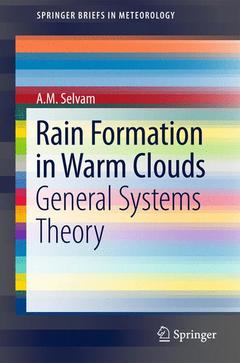Description
Rain Formation in Warm Clouds, 2015
General Systems Theory
SpringerBriefs in Meteorology Series
Author: Selvam A. M.
Language: English
Subject for Rain Formation in Warm Clouds:
Approximative price 52.74 €
In Print (Delivery period: 15 days).
Add to cart98 p. · 15.5x23.5 cm · Paperback
Description
/li>Contents
/li>Biography
/li>Comment
/li>
This book aims to promote the understanding of some of the basic mathematical and scientific issues in the subjects relating to climate dynamics, chaos and quantum mechanics. It is based on substantial research work in atmospheric science carried out over twenty years.
Atmospheric flows exhibit self similar fractal fluctuations, a signature of long-range correlations on all space-time scales. Realistic simulation and prediction of atmospheric flows requires the incorporation of the physics of observed fractal fluctuation characteristics in traditional meteorological theory. A general systems theory model for fractal space-time fluctuations in turbulent atmospheric flows is presented and applied to the formation of rain in warm clouds. This model gives scale-free universal governing equations for cloud growth processes. The model predicted cloud parameters are in agreement with reported observations, in particular, the cloud drop-size distribution. Rain formation can occur in warm clouds within 30 minutes as observed in practice under favourable conditions of moisture supply in the environment. Traditional cloud physical concepts for rain development requires over an hour for a full-sized raindrop to form.
The book provides background reading for postgraduate students of Meteorology, Atmospheric Sciences/Physics, Environmental Sciences, and scientists working in the field of the topic of the book as well as the multidisciplinary field of Nonlinear Dynamics and Chaos.
General Systems Theory Concepts in Atmospheric Flows.- Cumulus Cloud Model.- Universal Spectrum for Atmospheric Suspended Particulates: Comparison with Observations: Data set I.- Universal Spectrum for Atmospheric Suspended Particulates: Comparison with Observations: Data set II.- Universal Spectrum for Atmospheric Suspended Particulates: Comparison with Observations: Data set III.
First book to apply general systems theory to rain formation in warm clouds
Self-organized criticality (SOC) in atmospheric convection and precipitation
Includes supplementary material: sn.pub/extras




